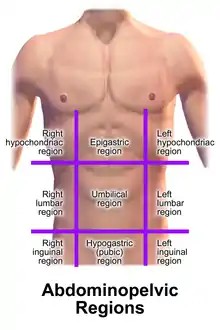
In human anatomy, the groin also known as the inguinal region or iliac region,[1] is the junctional area between the torso and the thigh.[2] The groin is at the front of the body on either side of the pubic tubercle, where the lower part of the abdominal wall meets the thigh.[3][1] A fold or crease is formed at this junction known as the inguinal groove, or crease. This is also the area of the medial compartment of the thigh that contains attachments of the adductor muscles of the hip or the groin muscles. The groin is the common site for a hernia.
Gross anatomy
Where the lower part of the anterior abdominal wall meets the thigh, a crease is formed known as the inguinal groove or crease. The junction is the area of the medial compartment of the thigh that contains the attachments of the adductor muscles of the hip also known as the groin muscles.
The adductor muscles that make up the groin consist of the adductor brevis, adductor longus, adductor magnus, gracilis, and pectineus.[4] These groin muscles adduct the thigh (bring the thigh and knee closer to the midline).
The groin is innervated by branches of the lumbar plexus. The pectineus muscle is innervated by the femoral nerve, and the hamstring portion of adductor magnus is innervated by the tibial nerve.[5]
In the groin, underneath the skin, there are three to five deep inguinal lymph nodes that play a role in the immune system. These can be swollen due to certain diseases, the most common one being a simple infection, and, less likely, from cancer. A chain of superficial inguinal lymph nodes drain to the deep nodes.
There are two depressions called fossae in an area called the inguinal triangle – the lateral inguinal fossa and the medial inguinal fossa.
The inguinal ligament runs from the pubic tubercle to the anterior superior iliac spine, and its anatomy is very important for hernia operations.
Clinical significance
A pulled groin muscle usually refers to a painful strain of the hip adductor muscles.[6]
An inguinal hernia is a hernia of the groin and can be either a direct hernia, or an indirect hernia according to its particular location. Sometimes a direct hernia may be present with an indirect hernia on the same side when it is known as a saddlebag hernia.
Like other flexion surfaces of large joints (popliteal fossa, armpit, cubital fossa and essentially the anterior part of the neck), it is an area where blood vessels and nerves pass relatively superficially, and with an increased amount of lymph nodes.
In a venography procedure, the groin is the preferred site for incisions to enter a catheter into the vascular system.
See also
- Athletic pubalgia
- Loin (space between the ribs and pelvis)
References
- 1 2 "Inguinal Region Anatomy: Overview, Gross Anatomy, Pathophysiological Variants". 19 July 2021. Retrieved 17 June 2023.
- ↑ Moore, Keith L.; Dalley, Arthur F.; Agur, Anne M. R. (2018). Clinically oriented anatomy (Eighth ed.). Philadelphia Baltimore New York London Buenos Aires Hong Kong Sydney Tokyo: Wolters Kluwer. p. 718. ISBN 9781496347213.
- ↑ "WebMB.com: Groin problems and injuries". Retrieved 2008-08-23.
- ↑ Kenneth S. Saladin (2010). Anatomy & Physiology: The Unity of Form and Function (5th ed.). McGraw Hill. OCLC 743254985.
- ↑ "GetBodySmart.com". 19 September 2017.
- ↑ "Amemmbwa". Archived from the original on March 19, 2006. Retrieved 2008-08-23.